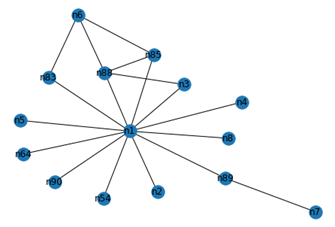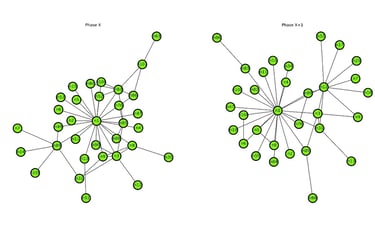Network Analysis
OUR STORY
Criminal network Study


The network under scrutiny consists of 110 individuals, with players numbered 1 to 82 engaged in trafficking activities, while players numbered 83 to 110 perform various other roles. Initially, the investigation primarily targeted the leader, D.S. However, during phase 4 of the investigation, a seizure occurred, prompting the traffickers to shift their focus to importing cocaine from Colombia. Consequently, the shipments now pass through the United States. While analyzing the data files, specifically phase1.csv and phase2.csv, we discovered matrices that provide insights into the number of wiretapped correspondences between 23 players within the network. Each player is identified by a unique identifier ranging from n1 to n110.
Load Dataset
phases = {}
G = {}
for idx, filename in enumerate(files):
index = int(re.findall('[0-9]+', filename)[0])
var_name = "phase" + str(index)
phases[index] = pd.read_csv(filename, index_col = 0)
phases[index].columns = "n" + phases[index].columns
phases[index].index = phases[index].columns
# create graph from pandas data frame
G[index] = nx.from_pandas_adjacency(phases[index])
G[index].name = var_name
evolution of the number of node and number of edges over time, from phase 1 to 11.
In [4]:
nodes = []
edges = []
for index in range(1,12):
print("Phase {} has {} Nodes and {} Edges".format(index, len(G[index].nodes), len(G[index].edges)))
nodes.append(len(G[index].nodes))
edges.append(len(G[index].edges))
This case presents a unique opportunity to study the dynamics of a criminal network. The time-varying network was thoroughly examined, conducting an analysis that provided a general outline of its structure, how it evolved over time, and the significance of each player's role within it. The ultimate goal was to take out the most connected member(s) and break down the network. The method that has been developed through this analysis can be used for high-dimensional network security. By understanding the structure and evolution of criminal networks, law enforcement agencies can better target key individuals and disrupt their operations effectively. This research opens up new possibilities in combating organized crime and maintaining network security.
RESULT
Phase 1 has 15 Nodes and 18 Edges
Phase 2 has 24 Nodes and 28 Edges
Phase 3 has 33 Nodes and 56 Edges
Phase 4 has 33 Nodes and 48 Edges
Phase 5 has 32 Nodes and 39 Edges
Phase 6 has 27 Nodes and 47 Edges
Phase 7 has 36 Nodes and 49 Edges
Phase 8 has 42 Nodes and 58 Edges
Phase 9 has 34 Nodes and 44 Edges
Phase 10 has 42 Nodes and 50 Edges
Phase 11 has 41 Nodes and 50 Edges
I used the following Python program packages:
import numpy as np # linear algebra
import pandas as pd # data processing, CSV file I/O (e.g. pd.read_csv)
import networkx as nx
import seaborn as sns
import regex as re
import operator
import matplotlib.pyplot as plt
# !apt-get install graphviz graphviz-dev
# for graph visulization
!conda install -y graphviz pygraphviz
Intrested in following the role of 23 of the players in the “D.S. organization" by using Centrality Measures of all 23 Selected Members. I used three Centralities; Degree Centrality, Betweenness Centrality and Eigen Vector Centrality.
To answer this questions, I looked at the temporal evolution of the networks and calculate the mean centrality for each of the centrality metrics, across all phases, for every player.
Results: We learned that First Major Event Happened in Phase 4. If we want to know the effect of Phase 4 Event then we should analyse how Graph changes in Phase5 because of preceding event in Phase4.


First Major event happened in Phase 4, first seizure, happened in Phase 4. This forced the traffickers reoriented to cocaine import from Colombia, transiting through the United States.
Direct effect of this is that new sub network emerge in network that facilitate cocaine import operation in Phase 5 ( Node n12 and it's connection)
This inference is supported by how the node influence is changed during Phase 4 and Phase 5. We can clearly see from the Centrality measures that n12 is important node that emerges in Phase 5.
